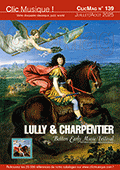 À travers ces trois enregistrements en première mondiale, on redécouvre une petite partie de l’œuvre de la prolifique compositrice française Fernande Decruck. Des nombreuses pièces qu'elle consacra au saxophone, c’est la sonate en ut dièse (1943) qui est la plus renommée dans sa version pour saxophone alto et piano. Elle est ici enregistrée pour la première fois avec orchestre. Le velouté, la clarté et l’agilité virtuose et mélodieuse de l’instrument y trouve un écrin de choix. Il y est enrobé d'une riche et chaleureuse orchestration sublimant une composition à la musicalité enchanteresse et à la finesse remarquable. Tout aussi riche et expressif est le « Poème héroïque » pour trompette, cor et orchestre (1946). L’œuvre n’ayant probablement jamais été donnée en concert, cet enregistrement n’en est que plus rare. Un lyrisme prenant se développe au sein de trois mouvements aux caractères habilement contrastés et aux aspects tant grandioses que mystérieux. Le timbre féérique de la harpe s’intègre merveilleusement au sein de l’orchestration dynamique et dense du concerto (1944) qui lui est consacré. Là encore, Fernande Decruck s’y impose en maître de la narration musicale entraînant l’auditeur au sein d’une œuvre fabuleusement captivante. De bien belles œuvres à découvrir ! (Laurent Mineau)  French composer Fernande Breilh-Decruck showed signs of a promising career from an early age, when she won several prizes at the Conservatoire National Supérieur de Paris (harmony, fugue, piano). As an assistant professor of harmony, she trained many students, including one who became very famous and later dedicated her a score: “To Fernande Decruck, with all the gratitude and fond memories of the author – Olivier Messiaen”. The Sonata in C-sharp for alto saxophone (or viola) is Decruck’s best-known work. Decruck created two versions of her world-famous sonata, one with saxophone or viola and piano, the other with full orchestral accompaniment. The latter version is rarely heard. Decruck combines the classical sonata form with impressionistic harmony and, at times, polytonality. Written in 1946, Poème Héroïque is a double concerto for solo trumpet, solo horn and orchestra. The work often features the two solo instruments in imitation and is a fantastic example of Decruck’s mature style. Divided into 3 contrasting movements, the piece sounds more American and Neo-Romantic than French. At times, it can sound mysterious and ethereal. Other sections have a driving, perpetual motion character. Decruck experiments using contrasting time signatures like 24/16 and 2/4. The Concerto pour harpe et orchestre was dedicated to and premiered by French harpist and pedagogue Pierre Jamet in 1946. Jamet later became the harp professor at the Paris Conservatoire in 1948. Decruck’s Concerto shares similarities with Germaine Tailleferre’s Sonate pour harpe. It is a concertino in style, light-hearted, warm, and full of surprises.
 |
